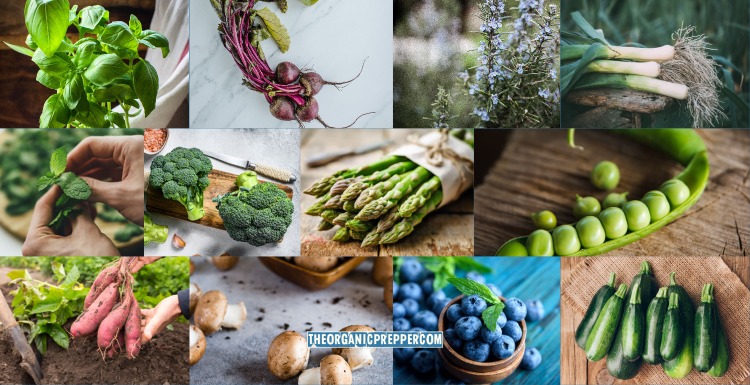If you're new here, you may want to subscribe to my RSS feed. Thanks for visiting!
Author of Be Ready for Anything and Bloom Where You’re Planted online course
(April 29, 2019) Finally….the week we’ve all been itching for. At least where I live, it’s planting time! Did you ever wonder exactly how to grow specific vegetables in your garden for the biggest, healthiest harvests?
I’ve spent the past few weeks pouring over my gardening books and scouring the internet to learn all that I can about the specific veggies, fruits, and herbs that I intend to grow. While lots of folks just stick everything in the ground and grow it under the same conditions, (exactly what I’ve been doing) I believe that a little attention toward the specific needs of individual plants can reward you with greater productivity and healthier plants. Below, you can find a round-up of the information I am using to set up my garden. I hope some of this is useful to you, as well.
How to Grow Specific Fruits and Vegetables
Bush beans (square foot gardening method)
Potatoes (Hilling method)
Potatoes (Towers)
Potatoes (Containers)
Tomatoes: This is the best tomato-planting advice I’ve seen. I’m trying his method this year.
Be sure to also check out the Self-Reliance Manifesto for more than 300 links to other gardening and homesteading tips.
Planting Time Books and Products
These are the books that I referred to when planning this year’s garden.
- The Vegetable Gardener’s Bible
- Lasagna Gardening
- Straw Bale Gardening
- The All New Square Foot Gardening
I’m also a big proponent of Smart Beds. If you don’t have construction skills (ahem – me – cough) they are a great way to make yourself a raised bed on top of any surface. The price is very reasonable too.
Tell us about your garden
Is it planting time where you are? What are you planning to grow this year? Do you grow plants specifically to certain guidelines or do you grow everything the same way? Please share your very best tips and tell us about your gardens in the comments.
About Daisy
Daisy Luther is a coffee-swigging, adventure-seeking, globe-trotting blogger. She is the founder and publisher of three websites. 1) The Organic Prepper, which is about current events, preparedness, self-reliance, and the pursuit of liberty; 2) The Frugalite, a website with thrifty tips and solutions to help people get a handle on their personal finances without feeling deprived; and 3) PreppersDailyNews.com, an aggregate site where you can find links to all the most important news for those who wish to be prepared. Her work is widely republished across alternative media and she has appeared in many interviews.
Daisy is the best-selling author of 5 traditionally published books, 12 self-published books, and runs a small digital publishing company with PDF guides, printables, and courses at SelfRelianceand Survival.com You can find her on Facebook, Pinterest, Gab, MeWe, Parler, Instagram, and Twitter.


















On your bush bean link. I think nine plants per square foot is too dense. Because of the cool nights and short season here in Alaska I grow my beans in the hoop house. I rotate 3 foot by 20 foot raised beds to beans. In a three foot wide raised bed I grow two double rows of provider beans with drip irrigation . I space bean plants 4 inches apart. Since I am growing through IRT plastic mulch I start the seeds in trays of 1.5 inch cells and transplant through holes in the plastic with a dibber ( or is it dibble). With this spacing all my space is filled and the plans hang over the sides in the path. My best year gave me 60 pints plus lots of fresh eating.
I am lucky to have a garden-savvy friend who helped me get a few dozen plants in the ground two weeks ago (which in CT where I live is really early, but I’m near the coast so we stay warmer than in-land) so I’ve already harvested some beet greens and lettuces. A heavy layer of mulching helps (newspaper or black plastic or shredded leaves). And I keep old shower curtains and comforters out back to “tuck in” the plants if there is danger of frost.
My friend taught me how to get the most value from a small garden: plant short time-to-harvest plants in between long-growing types. So for example, I have a row of summer squash starts, with the lettuce and some beets in between. I can harvest the lettuce and beet greens, then the beets, and finally when the squash begin producing they will have the row to themselves! I’ve also been wanting to try the “Three Sisters” version of corn, beans, and squash together, but have had terrible luck with corn.
And our biggest problem on the East Coast right now is sooooo much rain. I fear my potato starts and beans will rot in the ground before they get going. Sometimes things you just throw in on a whim pan out well, I just put oodles of peas out there, and now with all the rain about 30 plants are coming up! I may even put in a second row in order to ensure successive harvests. The garlic I planted last fall is greening up, and I interspersed onions too. Overall, should be a good garden year!
Wow, it sounds like you’re going to have a wonderful garden this year!
DH made tomato cages from the wire mesh used in cement floors. The cross wire is cut next to the up right wire leaving the cross wire on the other piece long enough to make a hook to hold the circle together. Much stronger & doesn’t tip over with a heavy plant. Last year we experimented with the same mesh for growing cucs on. It is placed standing up in a semi circle It holds the cucumber vines up of the ground & I am not risking life & limb trying to get through the patch. This year I hope to have the whole patch done that way.
Oh, I like those ideas a LOT!
My husband also made tomato cages out of the rebar. He is now making one that is designed like a hoop house for my luffa’s to grow.
I am late in getting my plants in the ground this year. Although I started the seeds in pots early, I was out of town for three weeks due to a family emergency.
Here in West Texas we do not have a long growing season, but two short seasons. June & July are in the 100’s. That is why I buy the short season plants. I have a mixture of raised beds and containers.
I am gravitating more towards the 30 gallon, white barrels with the tops cut off and a drain hole 6 inches from the bottom. I fill a little with rocks for drainage, then the rest with dirt & mulch. I fill to six inches below the top. This gives the smaller plants chance a fighting chance from our constant winds to grow. The plants are protected from most bugs, plus I can easily cover the barrel when we have a late chill. The barrels only hold one plant each. The barrels retain the water better.
I have 455 acres so space is not the issue, but the dirt out here is not the best. I put good soil in the barrels. My plants in the barrels are doing much better than the same ones in the raised beds.
Unfortunately your how to grow Turnips link just goes to Good Housekeeping, not an article and no opportunity to reference on the GH page.
Oh – sorry about that, Jan – I’ll fix it ASAP. Thank you for letting me know!
Hi Daisy, You are right, every plant has its own special needs and taking care of them all is like taking care of the individual needs of ones different children. But that’s what makes gardening so interesting, right? Thanks for the useful post and links. I’m also excited for planting and growing season!
We’ve had such a battle with gophers and other nibbling critters that we’ve put together a couple of styles of above ground gardening boxes. DH went to a lumber/hardware store and dumpster-dived a number of good plywood pieces, 4x4s and lath pieces. Being a handy guy he made me two above ground planter boxes 4’x3′ with a canopy and shelving ledges. We filled these with soil and compost. The box portion is at waist height making it very easy to reach everywhere. These little beauties also eliminated our slug problem. We have dogs and just hate using any kind of poison around the yard.
We’ve had these boxes about 4 years and they are still going strong. The original kale and chard are still going with just cutting what we want. They seem to last forever. Very easy for lettuce growing. Carrots and beets do well with some other misc. sized boxes lower to the ground but set up off the ground by some scrape boards. We were shocked that the gophers were taking out our tomatoes so those too have gone into some extra large black containers from a nursery dumpster. Even here in SoCal, spring is slow in coming. But the lettuce has been great so far! We’re having beets tonight. Zucchinis are in the ground and green beans are next. We may do those in a container because they’ve not done well since the gopher problem. If your neighbors don’t catch gophers too, they just proliferate. But we are eating out of our garden because of our cheapo garden boxes. 🙂
DH has become a gopher warrior. LOL!
Years ago when our children were still in the house, we had a very large successful garden. Once the children left the nest we didn’t feel the need for a garden. Now, we think a small raised bed garden will suit us. Just started by setting up the boards and planting two peach trees and two blue berry bushes next to the raised bed.